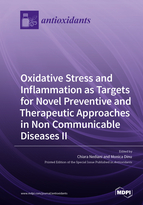Oxidative Stress and Inflammation as Targets for Novel Preventive and Therapeutic Approaches in Non Communicable Diseases II
A special issue of Antioxidants (ISSN 2076-3921). This special issue belongs to the section "Health Outcomes of Antioxidants and Oxidative Stress".
Deadline for manuscript submissions: closed (31 July 2021) | Viewed by 39477
Special Issue Editors
Interests: oxidative stress; redox signaling; autophagy; heart failure; oleuropein; bioactive natural compounds; polyphenols
Special Issues, Collections and Topics in MDPI journals
Interests: nutrition; diets; umbrella review; cardiometabolic factors
Special Issues, Collections and Topics in MDPI journals
Special Issue Information
Dear Colleagues,
As recently reported by the World Health Organization, non-communicable disease (NCD) has been increasing over the last century, representing the main cause of death and disability for the general population regardless of age, region, or gender. NCDs are chronic diseases characterized by being of long duration and very slow progression. They account for most ageing-related diseases, including cardiovascular and neurodegenerative diseases, cancer, diabetes mellitus and chronic kidney disease. Inflammation, oxidative stress and dysregulated authophagy are common features in NCDs, and awareness is growing related to specific biomarkers of these features that can detail the pathogenesis and the evolution of the diseases, enable correct diagnosis and open up novel strategies of assessment and intervention. Due to the great interest that this topic has aroused, we propose Special Issue II, with the same aim of providing more insight into recent developments in the field. Contributions of both reviews of the literature and original research articles are invited from investigators worldwide describing the role of oxidative stress and inflammation, their interplay with autophagy, as well as their modulation through signaling pathways by novel preventive and therapeutic strategies, including drug combination with natural active compounds, in cell culture systems and preclinical animal models.
Human clinical studies aiming to analyze the effects (and eventually the gender response) of diets, functional foods, or natural bioactive compounds in the prevention or therapy of NCDs are also welcome.
Prof. Dr. Chiara Nediani
Dr. Monica Dinu
Guest Editors
Manuscript Submission Information
Manuscripts should be submitted online at www.mdpi.com by registering and logging in to this website. Once you are registered, click here to go to the submission form. Manuscripts can be submitted until the deadline. All submissions that pass pre-check are peer-reviewed. Accepted papers will be published continuously in the journal (as soon as accepted) and will be listed together on the special issue website. Research articles, review articles as well as short communications are invited. For planned papers, a title and short abstract (about 100 words) can be sent to the Editorial Office for announcement on this website.
Submitted manuscripts should not have been published previously, nor be under consideration for publication elsewhere (except conference proceedings papers). All manuscripts are thoroughly refereed through a single-blind peer-review process. A guide for authors and other relevant information for submission of manuscripts is available on the Instructions for Authors page. Antioxidants is an international peer-reviewed open access monthly journal published by MDPI.
Please visit the Instructions for Authors page before submitting a manuscript. The Article Processing Charge (APC) for publication in this open access journal is 2900 CHF (Swiss Francs). Submitted papers should be well formatted and use good English. Authors may use MDPI's English editing service prior to publication or during author revisions.
Keywords
- Oxidative stress
- Inflammation
- Redox signaling
- Bioactive compounds
- Cancer
- Cardiovascular disease
- Metabolic disease
- Chronic kidney disease
- Aging
- Alzheimer disease
- Gender difference








